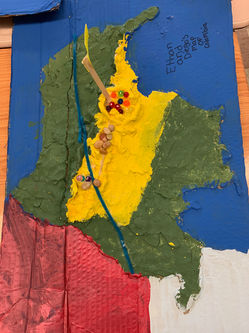I have been a Special Education Teacher for 12 of my 18 years of teaching in New York City. "All Children Can"is a motto I have adopted to describe my philosophy of education. I take a strength-based approach to education rather than a deficit-based approach. What does that mean? This means that when I make instructional decisions to close the gap between the present level of performance and grade level standards, I look to student strength as a stepping stone for growth. I teach my students to take healthy risks, set goals and to maintain a growth mindset. Most of my students are 4-5 years below grade level standards and I find that students make more growth when they are participating in a classroom that values their strengths, voices and interests. When you walk past my classroom door you often hear me call out, "What happens when we do hard things?" and my students return, "Our Brains Grow!"

All Children Can!
When I began bringing Global Education into my classroom 5 years ago, there was some surprise that I would attempt to discuss such sophisticated topics with students who were so far behind as readers, writers and mathematicians. Why would I prioritize global competency when I should be prioritizing raising those reading levels or getting students to fluently multiply decimals? Didn't I have IEP goals to focus on? Why would students with disabilities need to have Global Competence for their future?
My experience as a Special Educator has shown me that our students with disabilities have greater empathy for humanity than most abled-adults. Global Competency is rooted in empathy and our interconnected world demands that we understand there is more than one way to be a human on this planet. Children with disabilities are generally more accepting of diversity and have an implicit understanding that equity does not yet exist for everyone in this world. Children with disabilities are deeply impacted by environmental, political and economic decisions and they should be prepared to be part of those conversations. Our children are stakeholders in the health, wealth and prosperity of this planet.
As a teacher who works with 4th and 5th graders, I have witnessed the frustration students have when they are constantly being handed reading material that looks like it belongs in a kindergarten classroom. There is a time and place for guided reading but if we want our children with disabilities to stay engaged in school and feel empowered, we have to hand them content that is engaging and empowering. Having a disability classification does not mean you are unable to engage in global dialogue. A grade level article on the unfair treatment of refugees can always be scaffolded and supported with multimedia in order to give our students access. But without that access, they can't have deep and meaningful conversation about human rights. If they aren't given access to global topics, they aren't being given the opportunity to take local action on topics that are important to their communities. Also, there are so many ways you can use globalized content to address IEP goals in across subject areas and related services. 60% of my current students are multi-language learners and they are already connected on a global scale. Their stories and the stories of their families should be valued in our schools.
Finally, we have to remember that we are teaching children who will grow up to be voters and they will be civic participants. When I look at a class of 4th and 5th grade students, I see future voters and stakeholders. If you actively choose to leave out a group of students from a globalized lesson or unit, you are doing those future voters and stakeholders a disservice. This is why special educators are required to expose students with disabilities to grade level curriculum - children become voters and they are stakeholders.
Below, you will find some samples of student work from my classroom. Additional work will be featured in future blog posts. If you have further questions about the modifications and scaffolding I provided for students, please send me a message by completing the contact form.















